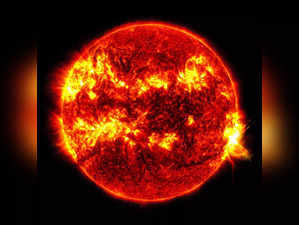 PTI
PTIFlorida: The sun produced its biggest flare in nearly two decades on Tuesday, just days after severe solar storms pummeled Earth and created dazzling northern lights in unaccustomed places.
"Not done yet!" the National Oceanic and Atmospheric Administration announced in an update.
It's the biggest flare of this 11-year solar cycle, which is approaching its peak, according to NOAA. The good news is that Earth should be out of the line of fire this time because the flare erupted on a part of the sun rotating away from Earth.
NASA's Solar Dynamics Observatory captured the bright flash of the X-ray flare. It was the strongest since 2005, rated on the scale for these flares as X8.7.
Bryan Brasher at NOAA's Space Weather Prediction Center in Boulder, Colorado said it may turn out to have been even stronger when scientists gather data from other sources.
It follows nearly a week of flares and mass ejections of coronal plasma that threatened to disrupt power and communications on Earth and in orbit. An ejection associated with Tuesday's flare appeared to have been directed away from our planet, although analysis is ongoing, Brasher noted.
NASA said the weekend geomagnetic storm caused one of its environmental satellites to rotate unexpectedly because of reduced altitude from the space weather, and go into a protective hibernation known as safe mode. And at the International Space Station, the seven astronauts were advised to stay in areas with strong radiation shielding. The crew was never in any danger, according to NASA.
"Not done yet!" the National Oceanic and Atmospheric Administration announced in an update.
It's the biggest flare of this 11-year solar cycle, which is approaching its peak, according to NOAA. The good news is that Earth should be out of the line of fire this time because the flare erupted on a part of the sun rotating away from Earth.
NASA's Solar Dynamics Observatory captured the bright flash of the X-ray flare. It was the strongest since 2005, rated on the scale for these flares as X8.7.
Bryan Brasher at NOAA's Space Weather Prediction Center in Boulder, Colorado said it may turn out to have been even stronger when scientists gather data from other sources.
It follows nearly a week of flares and mass ejections of coronal plasma that threatened to disrupt power and communications on Earth and in orbit. An ejection associated with Tuesday's flare appeared to have been directed away from our planet, although analysis is ongoing, Brasher noted.
NASA said the weekend geomagnetic storm caused one of its environmental satellites to rotate unexpectedly because of reduced altitude from the space weather, and go into a protective hibernation known as safe mode. And at the International Space Station, the seven astronauts were advised to stay in areas with strong radiation shielding. The crew was never in any danger, according to NASA.
(Catch all the Business News, Breaking News, Budget 2024 News, Budget 2024 Live Coverage, Events and Latest News Updates on The Economic Times.)
...moreDownload The Economic Times News App to get Daily Market Updates & Live Business News.
Subscribe to The Economic Times Prime and read the ET ePaper online.
Read More News on
(Catch all the Business News, Breaking News, Budget 2024 News, Budget 2024 Live Coverage, Events and Latest News Updates on The Economic Times.)
...moreDownload The Economic Times News App to get Daily Market Updates & Live Business News.
Subscribe to The Economic Times Prime and read the ET ePaper online.





